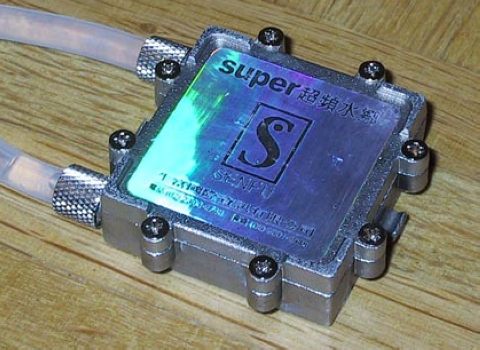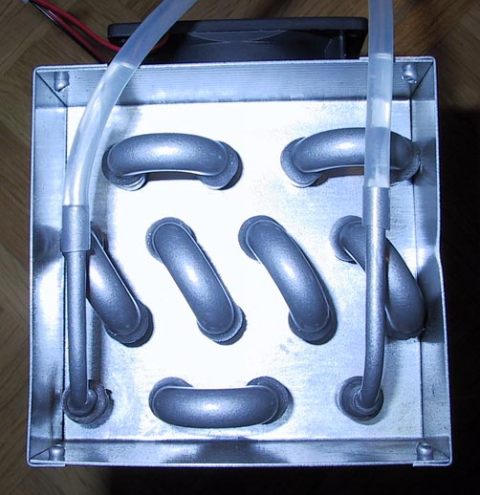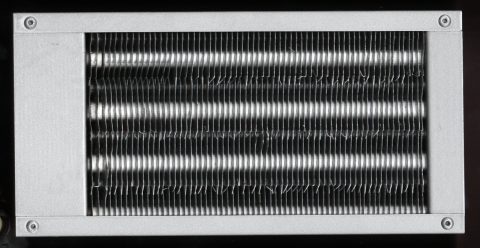senfu water cooler
by Tillmann Steinbrecher on 3/22/2000 7:40:46 PMSenfu Watercooler Unit
Posted in Cases/Cooling/PSUs
As the clock speed of today's processors increases, so does the amount of heat that they dissipate. The quest for more efficient cooling techniques has lead companies to experiment with everything from conventional air cooling to refrigeration. SENFU International Information Corp, a small Taiwanese company feels that water cooling is a potential solution to the problem. But is this really the future of cooling or just another hobbyist project?
Page 1
Watercooling a CPU isn't exactly a new idea - websites covering this topic have been online for a long time. However, the watercoolers mentioned on these sites are "do it yourself" solutions - and building such a watercooler takes a considerable amount of time and skill. Even though some retailers have been selling single parts for watercoolers, such as pumps or "water blocks", no complete, professional watercooling kit (including radiator and everything else you need) has been available until recently.A few months ago, a Taiwanese manufacturer - Senfu – took the challenge and entered the market with a watercooling kit. Now, it’s our turn to see how it measures up.
What you get
The Senfu watercooling system consists of three parts: The actual watercooler, to be mounted on the CPU, the water pump, and the radiator. Each part can be purchased separately. Senfu offers two different versions of the radiator - you can chose between a larger dual fan unit and a smaller single fan unit. Reviewed here is the dual fan version.
The performance
How well does the Senfu watercooler perform? Well, let's compare it to the two most efficient Athlon heatsinks, the Global WIN VOS32 and the Alpha P7125. Details about this test are described in the heatsink testing methodology article. The test CPU was an 0.25µ Athlon-650. The VOS32/P7125 results are taken from the February ‘00 Athlon heatsink roundup.
Test under real-world conditions
Cooler | Temperature |
Senfu watercooler | |
Global WIN VOS32 | |
Alpha P7125 YS Tech fans |
All values in °C.
Heatsink | Temperature |
Senfu watercooler | |
Alpha P7125 YS Tech fans | |
Global WIN VOS32 |
So, just from looking at the CPU temperature, one might say that the cooling performance might not justify the additional cost and possible inconvenience of a watercooler . However, with a watercooler, the heat generated by the CPU isn't dissipated inside the case but, instead, totally removed from the case. As you can see, this results in a lower case temperature. As soon as Peltier elements get involved, this advantage will become more obvious.
Page 2
The Heat ExchangerThe heat exchanger, or "water block", is the part of the watercooler the is in contact with the CPU, where the heat is transferred to the water. Here's a picture:


With the Senfu watercooler, there's no need to worry about leaks: The water block is absolutely leak-proof, and the attachment mechanism for fixing the tubes is very good; to prevent them from sliding off, they are secured using metal rings that can be screwed on the watercooler. Unfortunately, you can't use these rings for additional safety if you install the watercooler on an Athlon CPU, because otherwise only the rings around the tubes will touch the Athlon thermal transfer plate and not the base plate of the heat exchanger. However, even without the silver rings, the system is leak-proof.
Page 3
InstallationSenfu's water block comes in a box with many accessories. Included are clips and screws that allow mounting on almost any current CPU - Socket-type (K6, Celeron PPGA), SECC2 (P3 and newer P2), SEPP (Celeron Slot 1) and SECC1 (Athlon, old P2). For mounting on slot-type CPUs, an additional metal plate is included. The following picture shows the Senfu watercooler mounted on an Athlon thermal transfer plate:

On socket or SECC1 CPUs, clips should be used. However, the clips for Athlon are not very good; they don't press the watercooler very firmly against the CPU. Putting a thick piece of cardboard between the metal plate and the water block solves this problem, but this is still not a perfect solution. Also, with the Athlon mounting clips, you cannot install a Peltier element between CPU and watercooler. The mounting system for Athlon CPU definitely could be improved.
It is not possible to install the watercooler directly on the CPU die of an "opened" Athlon, unless you use thermoconductive epoxy to glue it on the CPU.
The compactness of the heat exchanger makes it suitable for hardcore overclockers who plan to watercool their graphics chip. Installed on a GeForce card (or any other video card), it won't even block the PCI slot right next to the graphics card! However, you'll need thermoconductive epoxy to install it on the graphics chip.
Page 4
Scope of deliveryApart from the clips and screws, the Senfu includes a very long clear plastic tube (much longer than required), a plastic jar with thermal compound, a spare o-ring for the "water block", and even a small Philips screwdriver to open the water block.
Also included are two large sheets of thin self-adhesive foam, which you can use for insulation, to prevent condensation if you're using the watercooler together with a Peltier element.
Consequences of using a watercooler
If you replace your CPU fan by a watercooler, then this will improve the cooling of the CPU. However, a CPU fan does more than just cool the CPU core - it allows also the cache chips of the CPU and the north bridge of the chipset to take advantage of a bit of fresh air. During testing, we noticed that the north bridge of the test system (K7M, AMD 751 north bridge) got very hot. However, this did not cause any instabilities at all. Nevertheless, especially if you're also overclocking the bus speed, some additional cooling for the north bridge might make sense if you're using a watercooler. A 40mm fan will perfectly fit the north bridge's heatsink and will cool it very effectively.
If you're using a SECC2 P2 or a "classic" P3, then it is also a good idea to let the cache run cooler by installing small heatsinks on the chips. This is not strictly necessary, but just like a CPU, a cache chip tends to overclock better if it runs cooler. With Athlon, Coppermine P3 and Celeron CPUs, extra cache cooling is not necessary - the Athlon's cache is cooled through the thermal transfer plate, and the Coppermine and Celeron CPUs have the cache on-die.
Page 5
The RadiatorWatercooling the CPU is nice, but once the water has "absorbed" the heat from the CPU, how do we cool it down? In the early days of watercooling, most users of self-made watercoolers simply used reservoirs with a few liters of water in order to cool the water down. However, with today's CPUs that dissipate over 50W, a simple reservoir won't suffice - after some time, the water will become too warm, and the watercooler will lose its efficiency. So, a better way to cool the water is needed: a radiator.

The Senfu dual fan radiator

Side view of the radiator. The thick tubes are made of copper.

The radiator's fins
The radiator consists of copper tubes with aluminum fins between them. Those familiar with car mechanics will notice that this radiator looks a bit like the heat exchangers that are used to heat our cars. The tubes inside the radiator have a wider diameter than the inlet/outlet, so that the water will stay longer inside the radiator. The radiator is equipped with two very efficient (but also quite loud) 80mm fans. The fans have pass-through power supply connectors and do not support rpm monitoring. The fans do not have finger guards. Since the radiator should be placed outside the computer case, those who have small children around should add additional finger guards to the fans.
The radiator does a fine job of keeping water temperatures low; it is by far sufficient for dissipating the heat generated by today's most power-hungry CPUs, and the dual fan unit can also handle the additional power dissipation of a Peltier element.
Since the radiator is also available separately, it is also a great choice for those who already have self-made watercoolers, but have trouble keeping the water temperature low.
Keep in mind that this radiator does not replace a water reservoir, since the Senfu watercooler is not a closed circuit cooling solution. The user will have to supply some kind of water reservoir.
Page 6
The PumpSenfu offers different types of pumps; we received the models WM333 and the L700. Both are standard immersable fishtank pumps. The WM333 isn't really strong enough for efficient watercooling; if the height difference between pump and watercooler is higher than about 60cm, it will not work at all. For testing, the stronger L700 pump was used.

Why? Because it is so excessively loud. When we first plugged in the pump, we were amazed that such a small pump can generate that much noise. The L700 pump probably makes the Senfu watercooling system the loudest cooling system available, it is even louder than the KryoTech vapor phase refrigeration system, which measured in at 39 dBA. The Senfu heat exchanger and the radiator leave an impression of very high quality, but the pump is definitely a disappointment.
However, this should not be a problem since you can purchase each part of the watercooler separately, and much better water pumps are available. Any pet shop that carries aquariums will have a selection of good water pumps, and shops specializing in aquaculture systems (e.g. www.aquatic-eco.com) will have an even wider selection of pumps. When shopping for a pump, there are two things to consider: 1) the pump must be strong enough to pump the water through the fine meanders of the watercooler and to handle the height difference between water reservoir and CPU, and 2) the pump must be suitable for permanent operation - fishtank pumps are suitable, but the little pumps for in-house waterfountains sometimes aren't.
Also, Senfu will be shipping noise improved versions of the L700 in the near future. It remains to be seen whether the new version will be significantly quieter.
Page 7
Performance ConclusionThe Senfu watercooler performs better than any conventional heatsink - however, not by much. You will have to decide for yourself whether the slightly better performance is worth the extra cost and the inconvenience of having an external radiator and a water reservoir around your PC. The advantages of the watercooler over a conventional heatsink will become more obvious once you add a Peltier element to the cooler, since Peltier elements create a lot of heat that somehow needs to be removed from the case.
Adding a Peltier element
Peltier elements can provide very effective cooling, but can also be very troublesome. A few points to consider are:
· The Peltier element must be suitable for the CPU used. This means that the power usage of the Peltier element must be significantly higher than the power usage of the CPU. For example, if you try to use a 50W Peltier element with a CPU that dissipates 50W, then the Peltier element will actually cause the CPU to overheat, because it cannot "transport" all the heat generated by the CPU. Senfu also offers a Peltier element, but it is rated at 54W, and thus is not powerful enough for most current CPUs.
· A Peltier element can cool your CPU below room temperature. This means that condensation might occur around the CPU, and good thermal insulation is necessary. Senfu includes self-adhesive foam for this purpose.
· A Peltier element consumes a lot of power! You might need an extra power supply for the Peltier element.
It is hard to predict what exact temperatures you will reach after installing a Peltier element. Setting up a good Peltier-based cooling system can take some experimenting.
Conclusion
The Senfu watercooler is recommended especially for very ambitious overclockers who would like to experiment with Peltier elements. For the average overclocker who would like to push his CPU just a bit further, good conventional heatsinks are probably the better choice.
Because of it's great compatibility with all CPU types, the Senfu watercooler is a very safe investment. And even if the heat exchanger won't fit future CPUs (that remains to be seen), you can simply upgrade to a new heat exchanger and keep using the radiator and the pump. The quality of the radiator and the heat exchanger is very good; they are perfectly leak-proof and will last many years. The pump, however, was not very convincing - better look out for alternatives.
Even though the Senfu watercooler is quite convincing (except for the pump), there's still room for improvement: The water channels inside the heat exchanger could have a larger diameter. Also, Senfu could come up with a closed-loop cooling solution that would eliminate the need for an extra water reservoir. The water reservoir is the most inconvenient thing about the watercooler; if you have to transport your PC around a lot, it can be especially annoying.
Unfortunately, Senfu's watercooler is not very widely available yet. The watercooler is also available in Japan and Taiwan, and at least one company in Germany will import the Senfu watercoolers in the near future.
Comments
Post a Comment